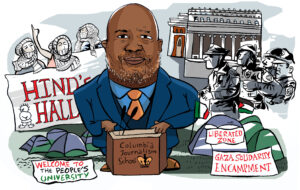
Mainstream news media and majoritarian state violence in India
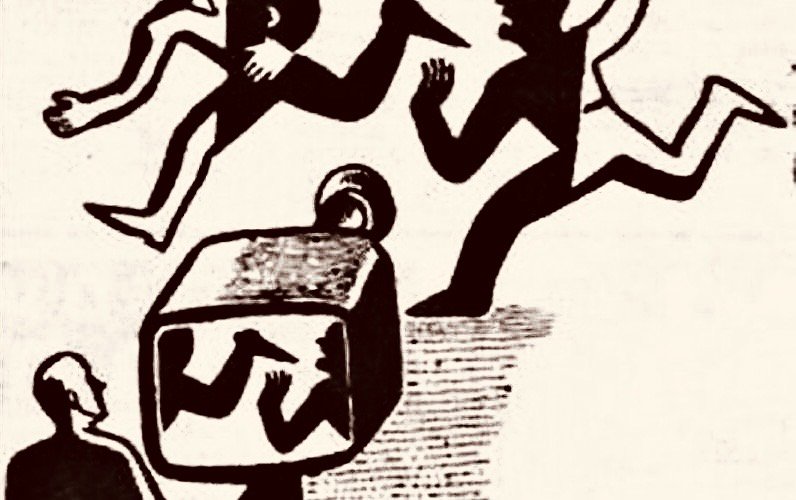
This essay looks at the links between mainstream news media narratives and majoritarian state violence to identify and understand how disinformation, propaganda and other covert tactics are employed to aid and abet state violence in India. Early findings of this research were presented at the 2021 Law and Society Association annual conference.
An overwhelming section of the mainstream media in India has been failing to perform its basic functions: to report, question and inform.
The media has the power to shape events, affect lives and influence the course of history. Its role as democracy’s fourth pillar has come under scrutiny with the ascent to power of the Bharatiya Janata Party (BJP) in 2014 and again in 2019. In the last few years, mainstream news media channels have openly and brazenly disseminated disinformation and propaganda. We borrow from Neelanjan Sircar’s definition of disinformation as a form of state sponsored violence: “In the Indian context, the sheer scale of government intrusions and control over the media emboldens it to strategically deploy misleading information — what is often called disinformation — to develop a national narrative supportive of the ruling BJP and Hindu nationalist ideology, as well as to harass government critics and the Muslim community in India.” Historian Ravinder Kaur, in her book Brand New Nation (2020), defines propaganda as “dis/information designed to alter ideas and belief” that tends to “obscure rather than reveal” complex processes in the time of post-truth and fake news (p. 17).
In this essay we argue that disinformation and propaganda employed with zero accountability make mainstream media complicit in furthering state violence in India. We define state violence as the physical, symbolic and structural violence that unfolds as a result of state action and or inaction while pursuing the majoritarian state’s agenda. Both disinformation and propaganda play an important function in creating the conditions to aid and abet the furthering of state violence.
The Indian state today is led by a party with a Hindu nationalist majoritarian ideology that is “pro-corporate and pro-upper caste.” (p. 1) The party has normalized an “anti-minority rhetoric” while routinely asserting the “imminent danger posed by internal as well as external enemies to the nation” using “systematic false claims and partisan facts.” (Ibid.)
According to the January 2019 Media Ownership Monitor report, with more than 118,239 registered publications, 38,933 weekly newspapers and monthly magazines, 36,564 monthly magazines, 17,160 dailies, 380 satellite channels, 550 radio stations and 1 news radio station, India has one of the largest media markets in the world.
Mainstream media in India is influenced by corporate and commercial pressure and represents powerful and elite sections of society, making it the voice of the privileged middle class, writes Antara Dev Sen in Pluralism and Democracy in India: Debating the Hindu Right. A 2019 study by Oxfam noted the vast under-representation of Other Backward Classes, Scheduled Castes and Scheduled Tribes in newsrooms in India especially at leadership levels. Mainstream media newsrooms are in fact mostly upper caste, elite spaces that are located in the Delhi National Capital Region (NCR), making media one of the most caste-segregated industries in India.
Since 2014, most national news channels have been uncritically supporting the BJP led-government and promoted hateful messages and propaganda that played a huge role in creating a divisive, communal and anti-Muslim atmosphere. In this manner, mainstream media has become a political instrument for the BJP-led government: a powerful machinery to propagate its majoritarian agenda for electoral gains at the cost of the country’s marginalized communities, critics and dissenters.
The mainstream news media, because of its sheer size, has the power to influence a large section of society and is likely to represent generally accepted beliefs and opinions. We use the term “mainstream news media” to refer to newspapers and television news channels in English and Hindi that have large audiences, big revenue, social media presence and star news anchors with primetime shows.
According to a 2017 Lokniti-Centre for the Study of Developing Societies survey, over half of the respondents said they trusted newspapers and television news channels, compared with only 29 percent who said they trusted information received through WhatsApp or Facebook. Even though higher internet penetration translated into at least 400 million users of WhatsApp, out of a population of nearly 1.4 billion, a 2020 CVOTER Media Consumption survey suggests that newspapers are perceived as more credible than television or digital media.
While mainstream news media narratives play a role in furthering the State’s ideology and the violence that it espouses, it is also important to understand the covert tactics that encourage bias and discrimination against critics and dissenters. These tactics become evident if we compare reporting around key events such as the North East Delhi pogrom in February 2020, the Nizamuddin Markaz Tablighi Jamaat gathering in March 2020, the Ram Janmabhoomi temple meeting in August 2020 and the Maha Kumbh Mela in April 2021.
*
One of the ways in which the mainstream media is complicit in state violence is by promoting majoritarianism in daily reportage. Minority communities are further marginalized through media narratives that make them even more vulnerable and prone to repression, criminalization and violence by state and non-state actors. There’s evidence that furthering violence through disinformation and propaganda makes the business of the mainstream media profitable.
We noted that, when star primetime anchors interview senior BJP leaders, their body language and speech shifts towards demureness, respect, modesty and flattery. Some news anchors even claim to have very close relationships with senior politicians, they tweet photographs of their meetings with BJP leaders, while the channels employing them host big conclaves platforming mainly ruling party leaders and spokespersons. Interviews with Prime Minister Modi mostly include ingratiating questions and, since 2014 when he became the Prime Minister, he has not held a single press conference. The only time he held one in 2019, he did not take any question and instead requested Amit Shah, then President of the BJP, to answer in his stead. While refusing press conferences, the Prime Minister has done interviews with film stars, appeared on Man Vs Wild with Bear Grylls and done scripted, choreographed interviews with star primetime news anchors.
The difference in behavior while dealing with the ruling party and the opposition is stark, it overrules journalistic ethics, undermines credibility and creates a sense of immunity for the Government and the ruling party. A corollary to this is the Government’s impunity and the resulting sycophancy of the ruling dispensation due to unchecked power. Christophe Jaffrelot, Angana Chatterji and Thomas Blom Hansen’s edited book Majoritarian State: How Hindu nationalism is changing India lists Modi’s “forceful masculinity/majoritarian” (pg. 7) political style and message as one of the reasons behind his success. This construction of a strong Hindutva leader is only possible through the substantial support of the mainstream media. The BJP’s win was also due to its “ability to saturate the public sphere with its message, greatly aided by open support from most of the privately owned media houses in the country.” (p. 7) The mainstream media is complicit in the increasing atmosphere of hate in the country because it does not question and criticize those in power.
The State’s systematic co-optation of mainstream media blurs the lines between mainstream and state-owned media and between news and propaganda. Stories and viewpoints that suit the Government’s version are common in the mainstream media. For instance, Asian News International (ANI) has been called out for making an employee pose as a common man for a story about demonetization in 2016. A study published by The Caravan looked at 1,779 primetime debates by the private pro government right-wing television news channel Republic TV from May 2017 to April 2020 and confirmed that the channel was “consistently biased in favor of the Modi government and its policies, as well as the ideology of the BJP.” The study also noted that the debates rarely featured important issues and mostly attacked the opposition and those who questioned the ruling dispensation’s ideology.
Amplifying biased hashtags that push a majoritarian narrative or headlines that repeat the Government’s version of the truth also contribute to this endeavor. Hashtags that champion Prime Minister Modi (#ModiCreatesHistory, #ModiStrikesBack #ModiMeansBusiness, #ModiStrikesCorruption) and attack the opposition (#SoniaCoverupExposed, #RahulInsultMartyrs, #CongAdmitsCAALie, #TikaitExposed) are used frequently on these news channels and so are Islamophobic hashtags (#CoronaJihad, #LandJihand) or hashtags against the Farmers’ Protest.
The launching of private and state-run news channels contributes to counter negative media reportage and put forward the Government’s agenda removing all expectations of media neutrality, trust, accountability and reliability. On 7 March 2021, just before the 2021 West Bengal state elections, R Bangla, a Bengali news channel, was launched by Arnab Goswami’s Republic Media Network. In September 2021, the India Today group launched Good News Today, “India’s first and only positive news channel.” In May 2021, when the Government’s mismanagement of the COVID-19 second wave was garnering international attention, there were talks of the Indian Government planning to set up a “BBC-like” channel with the objective to “project India’s point of view globally on contemporary issues of both global and domestic significance.” On 15 September 2021, Prime Minister Narendra Modi launched Sansad TV by merging Rajya Sabha TV and Lok Sabha TV. Newslaundry reported that apart from focusing on parliamentary issues, the channel also plans talk shows on Hinduism. When there is an overlap between the Government and the media, “the loser is the truth, as falsehoods win.”
*
What gets reported by the mainstream media is as important as what does not get covered while the tone, words and language used to report embody the covert and insidious ways in which biases are displayed and narratives are forged to suit the State’s agenda. The creation and regular usage of terms such as “anti-national,” “urban Naxal” and “anti-India” result in further division and hate and reaffirm existing biases and prejudices. The use of equalizing terms such as “clashes” and “encroachers” to report on issues where both parties are not at equal fault, or where the State itself is at fault, also misrepresents the nature of violence. Similarly, using “right-wing activists” to identify “right-wing vigilantes” normalizes right-wing terror and attributes positive connotations to their role in societal destruction.
One of the most egregious examples of the use of language to underplay state-sanctioned violence is the North East Delhi pogrom in February 2020. The pogrom took place in the larger context of the protests against the Citizenship Amendment Act (CAA) and the National Register of Citizens (NRC) laws that were passed in the Indian parliament on 11 December 2019.
The passing of the CAA and the NRC, along with the systemic discrimination of Muslims, sparked nationwide protests. In Delhi the protests took place with peaceful sit-ins led by citizens, which garnered support and visibility across the nation and on international media. In this context, violence broke out in North East Delhi on 23 February 2020 and spread across many neighborhoods in the city; it lasted for four days and left 53 dead, 39 of whom were Muslims. Republic TV reported on the violence as if the Police were victims, while in reality it led to a huge loss of life and destruction and looting of shops, homes and businesses in the areas that were affected. In the wake of this violence, several activists have been blamed for “masterminding a conspiracy” that allegedly led to the violence. These conspiracies, however, have been largely constructed by the Delhi Police, who blamed young Muslim activists and students for inciting violence and promoting anti-national activities. They also conveniently excluded incendiary speeches by Hindu nationalists that promoted violence against Muslims such as by BJP politician Kapil Mishra. Almost two years later, Kapil Mishra has no cases or legal action taken against him.
The link between media and majoritarian state violence became evident during Umar Khalid’s bail hearing in August 2021 for the Unlawful Activities Prevention Act (UAPA) case against him in the “Delhi riots conspiracy case.” During the hearing, it was established that the video clip of Khalid’s speech that the Delhi Police used in the charge sheet was based on Republic TV and News18’s coverage of Khalid’s speech given in February 2020. Upon further inquiry, it emerged that Republic TV had taken the edited clip from the Twitter account of the BJP IT head Amit Malviya.
The Delhi pogrom continues to be defined as a “riot,” a term that flattens the power inequality between Hindus and Muslims. Rajdeep Sardesai, a senior journalist from India Today, termed the pogrom as a riot, stating that both Hindus and Muslims were involved in terrible acts of violence. He tweeted that it was “tough to say who ‘started’ it” and blamed reactionary forces on both sides. In Delhi, Muslims are 12 percent of the population and formed 71 percent of the victims of the pogrom. During the four days of violence, the Police stood by while violent mobs attacked unarmed helpless people. The BJP-aligned media, such as OpIndia, claimed that a temple was occupied and attacked by Islamist fundamentalists, however independent media outlet Newslaundry revealed that it was fake news. The Delhi pogrom took place in the backdrop of the peaceful anti-CAA protests, but the BJP and their media allies portrayed the citizens and the protests as “anti-national.” The reportage around the pogrom and its relation to the anti-CAA protests led to the demonization of all those who question the Government and its policies.
While several mainstream media organizations presented a heavily biased understanding of the pogrom in favor of the Government, there were reporters and photographers on the ground who were assaulted and threatened for questioning the official narrative. These reporters did not receive any police protection and were assaulted by mobs that acted with impunity.
*
Dainik Jagran is the largest selling Hindi newspaper in India, which was established with the funding of Jagran Prakashan Limited in 1942 in Uttar Pradesh. The newspaper’s ground reportage during the pogrom was minimal and the incidents did not reflect on their cover page. Blaming the protestors for turning violent, the newspaper featured pictures of protestors pelting stones along with images of the Police getting beaten up and described as completely helpless. The infamous Kapil Mishra speech was also barely mentioned. Dainik Jagran also portrayed the peaceful and unarmed anti-CAA protests as sites of violence while in fact the protestors were themselves victims of police brutality.
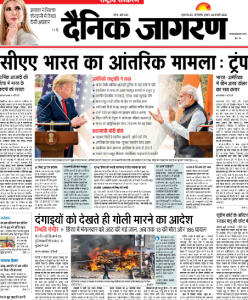
Shireen Azam, a doctoral researcher at the University of Oxford, argues that the growth of the Hindi-language press in North India is closely associated with the project of Hindu-nationalism and majoritarianism. From the 1980s, the right-wing paramilitary organization Rashtriya Swayamsevak Sangh (RSS) has aimed to influence the Hindi-speaking population’s interest and infiltrate the media. The proprietorial families of several leading Hindi publications all belong to the same caste, have closely aligned political leanings and support the RSS and the BJP.
*
The comparison between the way the media reported several large religious gatherings in 2020 and 2021 is indicative of the biased attitude of the mainstream media.
In March 2020, before the COVID-19 lockdown was imposed, a Tablighi Jamaat gathering took place in the Nizamuddin Markaz in New Delhi. The event was attended by 8,000-9,000 Muslims from India and abroad. By 18 April 2020, nearly 4,300 participants tested positive for COVID-19. The Indian media took this information as an opportunity to vilify the attendees making it a blatant case of Islamophobia and anti-minority rhetoric. The Indian Government, during a press briefing, announced that the Tablighi Jamaat event was a source of the COVID-19 spread in India. As we discussed elsewhere, “mainstream media outlets like Republic TV, Times Now, Zee News and various other right leaning news houses took over the Government narrative and amplified it to attack the gathering and the Muslim community in general.”
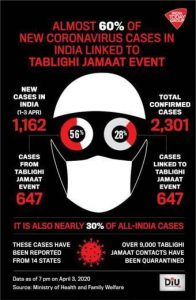
There is no dearth of evidence of Islamophobia by mainstream media during the Tablighi Jamaat event. Joyojeet Pal and colleagues at the University of Michigan studied media misinformation related to the coronavirus pandemic in the Indian media and found that news stories between 14 March and 12 April 2020 shifted from discussing a possible lockdown and infections to Muslims and religion. Pal and colleagues also found instances where official wings of the Government such as the Press Information Bureau purposefully spread misinformation. ANI was accused of spreading fake news on quarantine measures linked to the Tablighi Jamaat event. Researchers Soundarya Iyer of the French Institute of Pondicherry and Shoibal Chakravarty of the Divecha Centre for Climate Change, IISc., analyzed media reportage about the Jamaat from 20 March to 27 April 2020. They found that 11,074 stories published from 271 media sources mentioned Tablighi Jamaat. Similarly, an analysis by the Indian Journalism Review shows that Dainik Jagran kept up with a slew of Islamophobic content in 156 stories, eight editorials and five cartoons over 15 days from 28 March to 11 April 2020. According to a report by the Centre for Study of Society and Secularism, during the initial days and weeks of the COVID-19 lockdown, there was an explosion of fake news about Muslims deliberately spreading the virus. Hashtags such as #CoronaJihad, #CrushTablighiSpitters, #MuslimMeaningTerrorist and #BioJihad emerged on Twitter. #CoronaJihad appeared over 300,000 times on Twitter since the beginning of April 2020 and was potentially seen by 165 million people.
These media narratives that targeted the Muslim community had very real consequences: two attendees of the Nizamuddin event died due to denial of care and erratic food in a quarantine center in Delhi and there were several cases of people who were denied medical care by hospitals due to their religion. The direct impact of such media narratives also resulted in hate crimes against Muslims. The Bombay High Court on 21 August 2020, nearly four months after the barrage of misinformation, dismissed the charges against 35 Tablighi Jamaat petitioners and called out the scapegoating of Muslims in the Indian media. In March 2021, The Wire reported that “a year on, around 146 of the 3,500 or so attendees are still struggling to find their way home; 26 among them still await trial.”
In June 2021, based on a complaint by the Campaign Against Hate Speech, the News Broadcasting Standards Authority (NBSA) – an independent, adjudicatory body set up by the News Broadcasters Association (NBA) – ordered News18 Kannada (part of the News18 conglomerate) to air an apology and pay a fine of 100,000 rupees for their communal coverage of the Tablighi Jamaat event. Similarly, the NBSA also issued orders against Suvarna News (part of Asianet network) to pay a fine of 50,000 rupees while Times Now (part of the Times Group) was censured for their communal coverage of the Nizamuddin Markaz event.
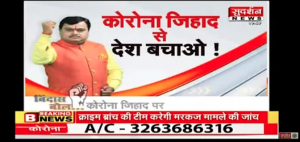
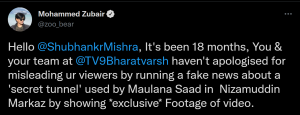
*
On 5 August 2020 India had a total of 1.96 million confirmed cases and 40,742 reported deaths due to COVID-19. The city of Ayodhya in Uttar Pradesh had 1,420 confirmed cases and 17 reported deaths while it hosted the Bhoomi Pujan, a ceremony to worship the land, for the highly contentious new Ram Mandir. The Bhoomi Pujan was attended by Prime Minister Narendra Modi, the RSS chief Mohan Bhagwat, the Chief Minister of Uttar Pradesh Yogi Adityanath as well as political and religious leaders. “It is not only a historic but also an emotional moment as after 500 years the Ram temple work will start. It will be the foundation of a new India,” Adityanath told reporters.
The ceremony was live telecasted along with updates of the puja throughout the day. The media narrative around the puja was different from that of the Nizamuddin gathering and the tone of reporting was that of rejoicing and celebration, with almost all political parties asking the country to celebrate it “as a source of unity.” A few days before the puja, the priest in charge of the ceremony and 16 policemen monitoring the site tested positive for COVID-19, prompting calls for the event to be postponed.
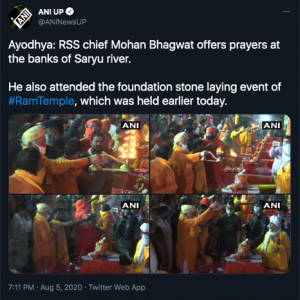
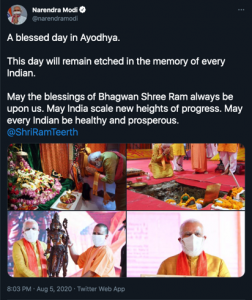
*
In April 2021, nearly three million devotees gathered on the banks of the holy river Ganga for the Maha Kumbh Mela, one of the largest Hindu religious gatherings in the world held every twelve years in Haridwar. The actual Maha Kumbh Mela was meant to happen in 2022, but was rescheduled for astrological reasons. In the second week of March 2021, a deadly second wave of the COVID-19 pandemic hit India, but the BJP central and state governments refused to call off the festival despite the public health emergency. In the first five days of the Kumbh Mela, 1,700 people tested positive for COVID-19. Soon afterwards, 99 percent of the Kumbh returnees of a town in central Madhya Pradesh also tested positive. Finally, on 17 April 2021, after the backlash and the rising number of cases, the Prime Minister “prayed” to keep the ongoing pilgrimage “symbolic” after thousands of people tested positive.
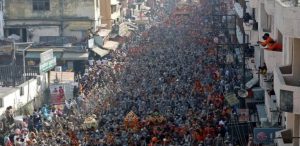
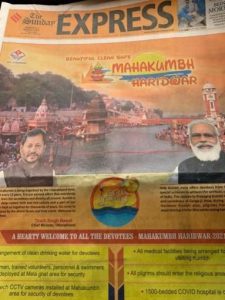
*
The loss of media freedom in India is directly connected to the rise of Hindutva nationalism and the construction of an atmosphere of hate and violence fueled by bigotry and propaganda. The 2021 World Press Freedom Index by Reporters Without Borders ranked India at a dismal 142 out of 180 nations. It is in this context that the mainstream media thrives in India today.
In her essay, Journalism as Genocide, Suchitra Vijayan discusses Rwandan cultural anthropologist Charles Mironko’s analysis of the confessions of 100 genocide perpetrators. His work confirmed that “hate messages in the media had a direct effect on the dehumanization of the population that was subject to persistent slander” and that “several months of this behavior, in the absence of credible reporting conditioned the population to hate and kill.” The conditions of genocide in Rwanda in the 1990s bear similarities to the plight of Indian Muslims in the 21st century. This was further substantiated when Genocide Watch, put a genocide warning for India, highlighting that the “Hindu nationalist policies of Prime Minister Narendra Modi and the Bharatiya Janata Party (BJP) have worsened anti-Muslim violence and caste oppression in India.” The reproduction of stereotypes of Muslims and the hateful communalization result in marginality and powerlessness among Muslims, writes Abdul Shaban. These stereotypes, labelling and stigmatization influence the population and consequently normalize violence.
A free press is a constitutional safeguard; its absence puts citizens at direct risk of violence at the hand of the State and of non-state actors that function with majoritarian sanction. The mainstream news media has direct responsibility in the normalization of Hindutva violence, the growing everyday attacks against minorities, Islamophobia, caste violence and violence against citizens. As India reaches a point of no return from the hate, bigotry and violence, it is up to mainstream news media to forgo its profit and vested interests in maintaining the status quo and hold the State accountable.



